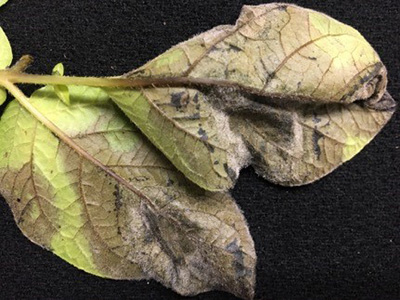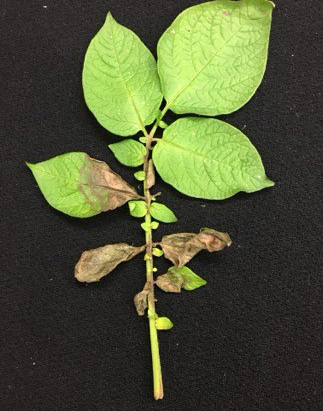Late blight was found in potato crops near Edmore, McBride and Vestaburg, Mich., Aug. 22 by ABC Consultants scouts. Initial genotyping confirmed isolates as US-23 by GPI isomerase testing, conducted by the Michigan State University Potato and Sugar Beet Pathology Laboratory. Mating type and Ridomil sensitivity testing are under way.
 Growers should be aggressively treating all fields on a minimum five-day schedule in Montcalm County, Mich. Applications should include a translaminar fungicide in combination with a protectant (chlorothalonil plus mancozeb) and Super Tin. Although a few fungicides have yet to be added, you can view the current fungicide rates here.
Growers should be aggressively treating all fields on a minimum five-day schedule in Montcalm County, Mich. Applications should include a translaminar fungicide in combination with a protectant (chlorothalonil plus mancozeb) and Super Tin. Although a few fungicides have yet to be added, you can view the current fungicide rates here.
Areas in fields that are particularly vulnerable are field margins, especially those close to tree lines, raised cable lines and where water can accumulate such as around pivot tracks and tractor wheel lines. Recommendations for late blight treatment remain the same as in previous reports posted at MSU Extension and include treating with one of the translaminar fungicides listed at the Michigan Late Blight Risk Monitoring website.
Conditions remain conducive for late blight development. See the station comparison page at Today’s Lateblight Forecast. Forecasts and disease severity value (DSV) accumulations can be checked daily at MSU’s Late blight Forecast page. Continued monitoring for late blight is recommended.
National late blight updates can be found at USA Blight. This resource provides updated information on the detection and characterization of late blight on potato and tomato crops in the U.S. This year, to date, late blight has been confirmed on tomato or potato in the states of Connecticut, Florida, Massachusetts, Maine, New York, North Carolina, Pennsylvania, Virginia, Washington and Wisconsin, and the Canadian provinces of Manitoba and Ontario.
 For the reported cases that have been genotyped, the pathogen was either US-23 or US-8 (Washington and Wisconsin). The US-23 clonal lineage has been reported in Michigan and most of the U.S. in recent years and in general is still managed well with phenylamide fungicides. There have also been reports of the US-8 clonal lineage in parts of the U.S. in recent growing seasons. US-8 is resistant to the phenylamide class of fungicides.
For the reported cases that have been genotyped, the pathogen was either US-23 or US-8 (Washington and Wisconsin). The US-23 clonal lineage has been reported in Michigan and most of the U.S. in recent years and in general is still managed well with phenylamide fungicides. There have also been reports of the US-8 clonal lineage in parts of the U.S. in recent growing seasons. US-8 is resistant to the phenylamide class of fungicides.
Continue scouting on a weekly basis where late blight has not been reported and treat fields aggressively in areas where late has been. Sample symptomatic plants and send them for diagnosis and continued application of residual protectant fungicides. Recommendations for appropriate late blight control where late blight has been confirmed or is suspected should include approaches suggested in the chart below and include desiccation of infected areas.
The indication of high risk was communicated early in the season to the industry; this included information from the university that winter temperatures may have resulted in a high likelihood that volunteer tubers would have survived the winter; feedback from scouts that survival of volunteer potatoes was profuse.
Recommended programs for late blight control are not straightforward. The product of choice may be dependent on how and where the disease has developed. Some possible scenarios are shown in the table below where a range of containment procedures is described for susceptible varieties and different levels of disease in the field.
|
Suggestions for appropriate fungicides for late blight control including semi-systemic fungicides under different late blight conditions in susceptible potato varieties.
|
|
Disease category
|
Late maturing, especially storage varieties
|
|
No senescence – early senescence
|
Mid – late senescence
|
|
A) None
|
Curzate or Tanos or Forum or Previcur Flex or Revus or Ranman + EBDC or chlorothalonil
Quadris or Headline or Gem + EBDC or Gavel
Omega
Champ or Kocide can be added to enhance activity
|
Curzate or Tanos or Forum or Previcur Flex or Revus or Ranman + EBDC or chlorothalonil+
Supertin/Agritin+ EBDC or chlorothalonil
Chlorothalonil or Gavel (various + ZN)
Omega
Champ or Kocide can be added to enhance activity
|
|
B) Few random lesions, even distribution throughout field (0 – 1 percent foliar infection)
|
Curzate or Tanos or Forum or Previcur Flex or Revus or Ranman + EBDC or chlorothalonil+TPTH
Or Chlorothalonil followed by EBDC+TPTH or Chlorothalonil + TPTH 5day
followed by Chlorothalonil (various + ZN)
Or Gavel
If metalaxyl sensitive strain found then use a Ridomil Gold-based product
|
Curzate or Tanos or Forum or Previcur Flex or Revus or Ranman + EBDC or chlorothalonil+TPTH
Or Chlorothalonil followed by EBDC+TPTH or Chlorothalonil + TPTH 5 day
followed by Chlorothalonil various + ZN)
Or Gavel
If metalaxyl sensitive strain found then use a Ridomil Gold-based product
|
|
C) One or more (up to 5) loci spreading from the edge of the field or from several centers within the field (1 percent overall field infection, but locally heavily infected plants 5 – 10 percent)
|
Curzate or Tanos or Forum or Previcur Flex or Revus or Ranman + EBDC or chlorothalonil+TPTH
Kill infected area with Reglone****
followed by EBDC+TPTH or Chlorothalonil + TPTH every 5 days until vines dead
If metalaxyl sensitive strain found then use a Ridomil Gold-based product
|
Curzate or Tanos or Forum or Previcur Flex or Revus or Ranman + EBDC or chlorothalonil+TPTH
Kill infected area with Reglone
followed by EBDC+TPTH or Chlorothalonil + TPTH every 5 days until vines dead
If metalaxyl sensitive strain found then use a Ridomil Gold-based product
|
|
D) Partial crop infection large areas infected with up to 20 percent loss of green leaf area evenly distributed throughout the field or large areas of the field
|
Curzate or Tanos or Forum or Previcur Flex or Revus or Ranman + EBDC or chlorothalonil+TPTH
Chlorothalonil (various + ZN) + TPTH kill infected area with Reglone
followed by EBDC+TPTH or Chlorothalonil + TPTH every 5 days until vines dead
If metalaxyl sensitive strain found then use a Ridomil Gold-based product
|
Curzate or Tanos or Forum or Previcur Flex or Revus or Ranman + EBDC or chlorothalonil+TPTH
Chlorothalonil (various + ZN) +TPTH kill infected area with Reglone
followed by EBDC+TPTH or Chlorothalonil + TPTH every 5 days until vines dead
If metalaxyl sensitive strain found then use a Ridomil Gold-based product
|
|
E) 20-100 percent crop infection with large loss of green leaf area***
|
Kill infected area with Reglone
followed by EBDC+TPTH or Chlorothalonil + TPTH every 5 days until vines dead
|
Kill infected area with Reglone
followed by EBDC+TPTH or Chlorothalonil + TPTH every 5 days until vines dead
|
* TPTH has seven-day post-harvest interval (max 11.25 ounces per acre per season).
** Chlorothalonil has seven-day post-harvest interval.
*** Protectant applications of an EBDC or chlorothalonil-based fungicide should be maintained on a five-day schedule until the vines are completely dead.
**** Infected areas should be treated last and a fungicide should be applied during the exit from the field.
Source: Michigan State University Extension